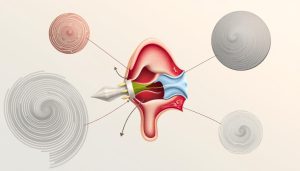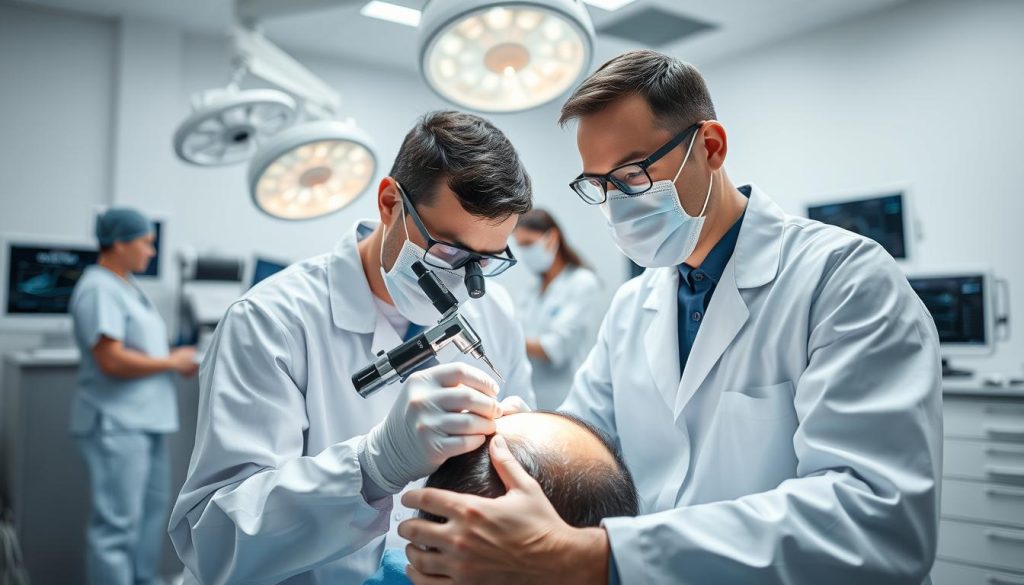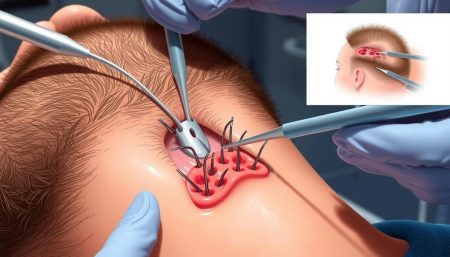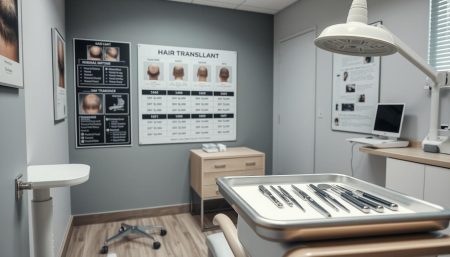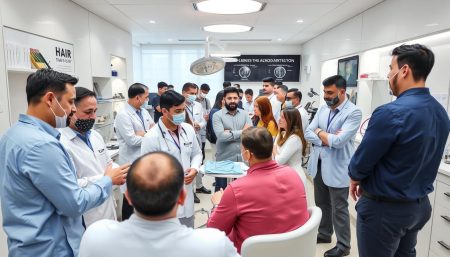Hair loss is a big problem worldwide, affecting millions. It can really hurt how people feel about themselves. Thanks to medical advances, hair transplantation is now a top choice for those wanting to grow back their hair.
This surgery has changed how we fight baldness. It gives hope to those with thinning hair or receding hairlines.
Hair transplantation moves hair follicles from thick areas to thin ones. It’s come a long way, now giving natural-looking results. Let’s look into why hair falls out, the treatments available, and how hair transplant surgery works.
Understanding Hair Loss: Causes and Impact
Hair loss is a big problem worldwide, causing worry and the search for good baldness treatments. Trichology, the study of hair and scalp health, shows many reasons for this common issue.
Genetic Factors and Pattern Baldness
Androgenetic alopecia, or pattern baldness, often runs in families. It happens when hair follicles get too sensitive to DHT, causing hair to thin and fall out. This problem affects both men and women, but men are more likely to lose their hair.
Medical Conditions Leading to Hair Loss
Many health problems can cause hair loss, needing special alopecia treatments:
- Alopecia areata: An autoimmune disorder causing patchy hair loss
- Thyroid imbalances: Both hyper- and hypothyroidism can affect hair growth
- Nutritional deficiencies: Lack of iron, protein, or vitamins can lead to hair thinning
Psychological Effects of Hair Loss
Hair loss affects more than just how you look. Many people feel:
| Psychological Effect | Percentage Affected |
|---|---|
| Decreased self-esteem | 75% |
| Anxiety in social situations | 60% |
| Depression | 40% |
It’s key to understand these factors for the right baldness treatments. Trichology experts say it’s vital to treat both the physical and emotional sides of hair loss for the best results.
The Evolution of Hair Restoration Techniques
Hair transplantation has evolved a lot over the years. It started in the 1950s with simple methods that didn’t always look natural. These early methods used big grafts, known as ‘hair plugs’, which made people look like dolls.
As people wanted better results, hair transplant techniques got better. The 1990s brought in follicular unit transplantation (FUT). This was a big step forward, allowing for smaller, more natural-looking hair groups.
The early 2000s saw another big change with follicular unit extraction (FUE). This method is less invasive and doesn’t leave a big scar. It lets doctors take out individual hair follicles one by one.
| Decade | Technique | Key Advancement |
|---|---|---|
| 1950s | Punch Grafts | First attempts at hair transplantation |
| 1990s | FUT | Smaller, more natural-looking grafts |
| 2000s | FUE | Minimally invasive, scarless technique |
Now, hair transplantation uses the latest in surgery and technology. Robotics and artificial intelligence are being used. They promise even better and more precise hair restoration in the future.
What is Hair Transplantation?
Hair transplantation moves hair follicles from one part of the body to another. It’s mainly for treating male pattern baldness. It can also restore eyelashes, eyebrows, beard hair, and chest hair.
Basic Principles and Methodology
The main idea is to take healthy hair follicles from dense areas. Then, they are moved to thin or bald spots. This method works because the transplanted hair keeps its original characteristics.
Candidate Eligibility Criteria
Not everyone can get a hair transplant. The right candidates have:
- Enough healthy hair in donor areas
- Good overall health
- Realistic hopes for the outcome
- Been losing hair for a few years
- Been over 25 for a while
Expected Timeline and Results
The time it takes to see hair transplant results varies. Here’s what you can expect:
| Time Frame | Expected Progress |
|---|---|
| 2-3 weeks post-surgery | Transplanted hair falls out |
| 3-4 months | New hair growth starts |
| 6-9 months | Noticeable increase in hair density |
| 12-18 months | Full results are seen |
Remember, hair transplantation is a slow process. Being patient is key to seeing good results. The success of the procedure also depends on choosing the right candidate and following care instructions after surgery.
Follicular Unit Extraction (FUE): Modern Approach
Follicular unit extraction has changed hair transplantation. It’s a new way to fix hair loss. Unlike old methods, FUE takes out single hair follicles and puts them in new places.
The first step is picking and taking out healthy follicles. These groups have 1-4 hairs. The doctor uses special tools to take out each one, leaving tiny scars that are hard to see.
- Minimal scarring
- Quicker recovery time
- Natural-looking results
- Flexibility in hairstyle choices
Even with its good points, FUE takes longer and costs more. It’s important to talk to a skilled surgeon to see if it’s right for you.
| Aspect | FUE | Traditional Methods |
|---|---|---|
| Scarring | Minimal, dot-like | Linear scar |
| Recovery Time | Shorter | Longer |
| Procedure Duration | Longer | Shorter |
| Cost | Generally higher | Generally lower |
Follicular unit extraction keeps getting better. New research is making it even more effective. As technology grows, this method will likely get even better and more available.
Follicular Unit Transplantation (FUT): Traditional Method
Follicular Unit Transplantation (FUT) is a well-known surgical hair restoration method. It has been a key treatment for hair loss for many years. It gives patients a chance to get back their natural hairline.
Strip Harvesting Technique
FUT involves taking a strip of skin from the back of the scalp. This strip has hair follicles that don’t fall out easily. Surgeons then split this strip into individual follicular units. These units are then moved to the thinning areas.
Recovery and Healing Process
The recovery from FUT usually takes 10 to 14 days. During this time, patients might feel some discomfort and swelling. The area where the strip was removed will heal with a thin linear scar. This scar can be hidden by the surrounding hair.
Comparing FUT vs FUE
Both FUT and Follicular Unit Extraction (FUE) are effective hair restoration methods. But they have some key differences:
| Factor | FUT | FUE |
|---|---|---|
| Scarring | Linear scar | Tiny dot scars |
| Procedure time | Shorter | Longer |
| Cost | Generally lower | Usually higher |
| Ideal for | Larger areas | Smaller areas |
Choosing between FUT and FUE depends on several factors. These include the extent of hair loss, the amount of donor hair, and personal preferences. Talking to a qualified hair restoration specialist can help decide the best option for each patient.
Advanced Technologies in Hair Restoration
The world of hair transplantation is changing fast. New technologies are making hair regrowth better. These changes help surgeons give patients better results.
Robotic-assisted hair transplantation is leading the way. It makes hair transplants more precise. This means patients get hair that looks more natural.
Stem cell therapy is also exciting. It uses a patient’s own stem cells to grow hair. Early results are promising, but it’s not fully developed yet.
| Technology | Benefits | Limitations |
|---|---|---|
| Robotic-assisted transplantation | Increased precision, reduced scarring | High cost, limited availability |
| Stem cell therapy | Potential for natural regrowth | Stillexperimental, long-term effects unknown |
| Platelet-rich plasma (PRP) | Enhances graft survival, stimulates growth | Requires multiple treatments |
These new technologies are making hair transplants better. They also open up new options for people wanting to grow their hair. As research goes on, we’ll see even more new ways to restore hair.
Pre-procedure Planning and Consultation
Before starting hair transplantation, a detailed planning and consultation is key. This includes medical checks, designing the hairline, and setting clear expectations. Trichology experts help guide patients through this critical phase.
Medical Evaluation Requirements
A detailed medical check is the first step in planning hair transplantation. This involves:
- Blood tests to check overall health
- Scalp examination to assess hair loss patterns
- Review of medical history and current medications
Designing the Hairline
Creating a natural-looking hairline is vital in hair transplantation. The surgeon and patient work together to design a hairline that suits the face and looks right for the age. This process includes:
- Analysing facial proportions
- Considering future hair loss patterns
- Using digital imaging tools for visualisation
Setting Realistic Expectations
Managing patient expectations is key for satisfaction with hair transplantation results. Trichology specialists talk about:
- Potential outcomes based on individual hair characteristics
- Timeline for visible results
- Limitations of the procedure
By covering these points during consultation, patients can make informed choices about their hair restoration journey.
The Surgical Process Step by Step
Surgical hair restoration is a detailed process aimed at natural-looking results. It starts with local anaesthesia to keep the patient comfortable. Once the scalp is numb, the surgeon begins the hair grafting.
Follicular Unit Extraction (FUE) involves taking individual hair follicles from the back of the head. These are then prepared for transplant. Follicular Unit Transplantation (FUT) removes a scalp strip, and follicles are dissected under a microscope.
The surgeon then makes tiny incisions in the balding areas. They consider the natural hair growth pattern for a seamless blend. The grafts are then placed into these sites with great precision and skill.
| Step | Description | Duration |
|---|---|---|
| Anaesthesia | Local anaesthetic applied to scalp | 15-30 minutes |
| Graft Extraction | Harvesting follicles from donor area | 1-3 hours |
| Recipient Site Creation | Making incisions for graft placement | 30-60 minutes |
| Graft Placement | Inserting grafts into recipient sites | 2-4 hours |
The whole procedure can take several hours, depending on the hair loss and grafts needed. Patients usually go home the same day. They get aftercare instructions to help with healing and graft survival.
Post-operative Care and Recovery
After hair transplantation, it’s vital to care for your hair properly. This ensures the best results and hair growth. The recovery has two main parts: immediate care and long-term maintenance.
Immediate Aftercare Instructions
Here are the key steps to follow right after your procedure:
- Keep the transplanted area dry for the first 48 hours
- Sleep with your head elevated to reduce swelling
- Avoid touching or scratching the recipient site
- Take prescribed medications as directed
- Wear a loose-fitting hat when outdoors to protect the scalp
Long-term Maintenance Guidelines
To keep your hair healthy and growing well, follow these tips:
- Use gentle, sulphate-free shampoos
- Avoid harsh styling products for the first month
- Protect your scalp from direct sunlight
- Maintain a healthy diet rich in vitamins and minerals
- Attend all follow-up appointments with your surgeon
Remember, patience is key during the hair regrowth process. It may take several months to see the full results of your hair transplantation. By following these guidelines, you’ll maximise your chances of achieving a natural, fuller head of hair.
Potential Risks and Complications
Hair transplantation, like any surgical hair restoration, has risks and complications. Most people have good results, but it’s important to know about possible issues.
Common side effects include swelling and numbness in the treated areas. These usually go away in a few days to weeks. But, in rare cases, patients might get an infection or poor graft survival.
Choosing a skilled surgeon and following their post-operative advice are key steps to reduce risks. Most problems can be managed with the right care and attention.
| Complication | Frequency | Management |
|---|---|---|
| Swelling | Common | Cold compresses, elevation |
| Numbness | Common | Usually resolves on its own |
| Infection | Rare | Antibiotics, wound care |
| Poor graft survival | Uncommon | Revision surgery if needed |
Talking about risks with your surgeon during the consultation is vital. They can give advice tailored to your situation and health history.
Cost Considerations and Financial Planning
Understanding the financial side of hair transplantation is key for those thinking about it. The cost can change a lot based on different factors. So, it’s important to plan well.
Price Factors and Variables
The cost of hair transplantation depends on several things. These include how much hair you’ve lost, the technique used, and the surgeon’s skill. More complex procedures or those by top surgeons usually cost more.
| Factor | Impact on Cost |
|---|---|
| Extent of hair loss | More grafts needed = Higher cost |
| Technique (FUE vs FUT) | FUE typically more expensive |
| Surgeon’s experience | More experienced = Higher fees |
| Clinic location | Urban areas often pricier |
Insurance Coverage Options
Most insurance plans don’t cover hair transplantation because it’s seen as cosmetic. But, if hair loss is due to burns or trauma, some might cover part of it. Always check with your insurance provider for details.
Financing Solutions
Many clinics offer financing to help make hair transplantation more affordable. This can include payment plans, medical credit cards, or personal loans. Some people use health savings accounts (HSAs) or flexible spending accounts (FSAs) to help pay for it.
When thinking about a hair transplant, look at all the financial sides. Compare prices from different clinics and check out financing options. Make sure you’re okay with the cost for your looks and confidence.
Alternative Hair Loss Treatments
Looking for alopecia treatment beyond hair transplants? There are many options. You can use them alone or with surgery to help your hair grow back.
Medicine is key in fighting hair loss. Finasteride is a pill that stops male pattern baldness. Minoxidil, a cream, makes hair follicles work better and hair grow longer.
Scalp micropigmentation is a non-surgical fix for serious hair loss. It tattoos the scalp to look fuller or shaved.
Low-level laser therapy uses light to wake up hair follicles. You can use special caps or combs at home, making it easy to use.
Platelet-rich plasma (PRP) therapy is becoming more popular. It injects your own platelets into the scalp to grow new hair and make existing hair thicker.
- Finasteride and minoxidil for hormone-related hair loss
- Scalp micropigmentation for a fuller appearance
- Low-level laser therapy for at-home treatment
- PRP therapy for natural hair regrowth stimulation
These treatments offer hope for those losing hair. They can be adjusted to fit your needs. Talking to a hair loss expert can help find the best way to get the results you want.
Choosing the Right Hair Transplant Surgeon
Finding a skilled hair transplant surgeon is key for a successful hair restoration. This choice affects your procedure’s outcome and how happy you’ll be with the results.
Credentials and Certifications
Make sure the surgeon has the right qualifications in trichology and hair transplantation. They should be board certified in dermatology or plastic surgery. Also, check if they’re members of groups like the International Society of Hair Restoration Surgery.
Portfolio Assessment
Look at the surgeon’s before-and-after photos of past patients. Notice the hairline, density, and how natural the results look. A wide range of hair types and techniques in their portfolio shows they’re experienced.
Patient Reviews and Testimonials
Read what past patients have to say. Focus on their experiences with the surgeon’s communication, care, and long-term results. Be cautious of clinics with only positive reviews, as this might be filtered feedback.
Ask about the surgeon’s experience with your hair type and loss pattern during consultations. Find out how many procedures they do each year and what follow-up care they offer. A good surgeon will be open about risks and set clear expectations for your hair transplant.
Long-term Results and Maintenance
Hair transplantation gives lasting results, but keeping up with care is key. The journey to full hair growth takes 12 to 18 months after the procedure. During this time, you’ll see your hair density and look improve slowly.
Transplanted hair grows and sheds like natural hair, in cycles. Though the transplanted follicles stay, your natural hair around them might thin. This could mean you might need more treatments to keep your hair full.
Keeping up with care is important for lasting results:
- Use FDA-approved meds like minoxidil or finasteride to help hair grow and stop loss
- Use a gentle hair care routine, avoiding harsh chemicals and too much heat styling
- Eat a balanced diet full of proteins, vitamins, and minerals for hair health
- See your surgeon regularly to check on your hair and talk about any issues
How you live affects how long your hair transplant lasts. Managing stress, getting enough sleep, and not smoking helps your hair. Remember, transplanted hair needs the same care as your natural hair to stay healthy and look good.
“The success of hair transplantation lies not just in the procedure itself, but in the patient’s commitment to long-term care and maintenance.”
By sticking to these tips and talking often with your surgeon, you can enjoy your hair transplant for many years.
Future of Hair Restoration Technology
The field of hair transplantation is changing fast. New techniques like hair cloning could bring endless donor hair. This could change how we treat hair loss, helping those with little donor hair.
Gene therapy is another big hope. Scientists are finding and changing genes linked to hair growth and loss. They want to make treatments that stop hair loss or make hair grow again, all without surgery.
Stem cell research is also showing promise. These cells might help grow new hair follicles or make old ones work better. This could be a gentler way to fix hair loss than traditional methods.
As new tech comes along, it’s key to keep up with it. Current hair transplant methods work well, but new ones might do even better. The future of hair regrowth looks very promising, with more choices and better results for those dealing with hair loss.
FAQ
Q: What is hair transplantation?
A: Hair transplantation moves hair follicles from the back or sides of the head to bald spots. It’s a lasting fix for hair loss.
Q: Who is a good candidate for hair transplantation?
A: People with enough donor hair and realistic hopes are good candidates. Those with bald spots or hair loss from injury fit well. A doctor’s check is needed to see if you’re a good match.
Q: What is the difference between FUE and FUT?
A: Follicular Unit Extraction (FUE) takes out single hair follicles. Follicular Unit Transplantation (FUT) removes a strip of scalp. FUE has less scarring and quicker healing, but FUT might give more grafts at once.
Q: How long does a hair transplant procedure take?
A: The time needed for a hair transplant varies. It can take 4 to 8 hours for one session, depending on the method and grafts.
Q: Is hair transplantation painful?
A: No, the procedure is done under local anaesthesia, so you won’t feel pain. You might feel some discomfort later, but this can be managed with medicine.
Q: How long does it take to see results from a hair transplant?
A: You might see some results in 3 to 4 months. But it takes 9 to 12 months for full results. The hair will fall out before growing back.
Q: Are hair transplant results permanent?
A: Yes, the transplanted hair usually stays, as it comes from resistant areas. But, you might lose hair in other areas, needing more treatments.
Q: What are the possible risks and complications of hair transplantation?
A: Risks include infection, bleeding, scarring, and hair that looks unnatural. But, these are rare with a skilled surgeon.
Q: How much does a hair transplant cost?
A: Prices vary a lot. They depend on hair loss, technique, surgeon’s skill, and location. In the UK, it can cost from £3,000 to £15,000 or more.
Q: Are there any alternatives to hair transplantation?
A: Yes, there are options like finasteride and minoxidil, scalp micropigmentation, and platelet-rich plasma (PRP) therapy. These can be used alone or with hair transplantation for better results.











